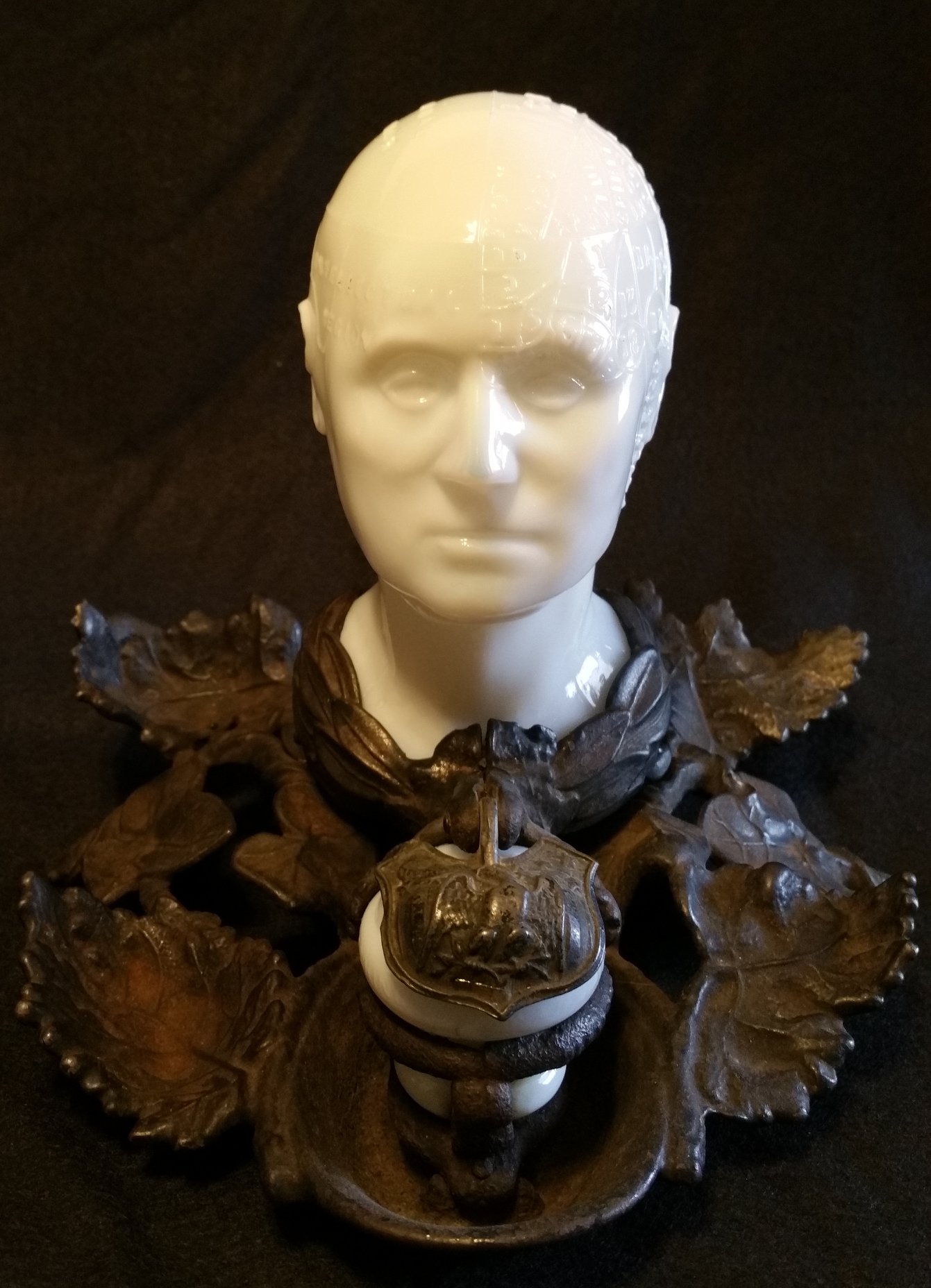
Phrenology Head Inkstand
| Categories | Figural - Persons, Mechanical - Pump / Siphon |
| Type | Science |
| Material | Cast iron, Milk Glass |
| Markings | See Narrative |
| Manufacturer | Undetermined |
| Origin | United States |
| Date or Era | circa 1866 |
| Measuring | 7 ½” x 7” x 6 ½” high |
| Patent | Patent No. 13,902 dated December 11, 1855 |
This inkstand features a bust of George Washington, with his iconic idealized head serving as the inkwell. The head and the small dipping font in front are a single, complex piece of milk glass (also known as opal glass). (Note: the bust can also be found made of clear glass). The glass is set within a cast iron frame that has been painted black, with a hinged lid for the inkwell’s font. The bust’s surface is marked with numbered divisions corresponding to phrenological “organs.”
The cast iron base is decorated with symbolism:
- Oak leaves on the base signify fortitude and strength.
- Ivy leaves represent fidelity and tenacity.
- Laurel leaves symbolize martial victory and success.
The sides of the base are shaped to form a cradle for holding pens. The hinged lid covering the font is decorated with an American eagle and a Federal shield, while its underside provides an important clue to the piece’s origin: it is marked “SEE WASHINGTON MANUAL BY // JOHN HECKER, / N.Y.” This directly links the inkstand to the 1866 manual by John Hecker, a guide to understanding the phrenology bust.
The inkwell itself is a fountain-type, as confirmed by the patent marking on the pen cup ring: “PATENTED DEC 11, 1855.” This refers to U.S. Patent No. 13,902, granted to Charles T. Close. The patented design is a self-feeding inkwell with a sealed reservoir, which prevents evaporation. As ink is used from the front font, air is allowed to enter the main reservoir through the connecting channel, allowing more ink to automatically flow forward and keep the font consistently full.
Phrenology: A 19th-Century Fad
Phrenology was a discipline developed in the late 18th century by German anatomist Franz Joseph Gall. It was based on the premise that an individual’s character and mental faculties could be determined by the shape of their skull. Gall believed that the brain was composed of distinct organs, each responsible for a different character trait or emotion, such as combativeness, self-esteem, or benevolence.
Gall claimed to have identified 27 of these “organs,” and he believed that the size of an organ’s brain mass would cause a corresponding bump on the skull. By measuring these bumps, a phrenologist could create a “map” of an individual’s personality. From about 1810 to 1840, phrenology gained widespread acceptance in Europe and America, becoming a cultural phenomenon.
Gall’s claims were often rooted in the biases of the time. For example, he asserted that women had undeveloped organs for success in the arts or sciences, but that their organs for religion and childcare were well-developed. Phrenology was also used to identify criminal tendencies, as a large bump in a specific area of the skull was believed to indicate a “criminal nature.” Although phrenology was debunked by the scientific community in the mid to late 19th century, it had a lasting impact on popular culture and the arts.
Links to related items in Inkipedia:
Phrenology Bust Inkwell – The Society of Inkwell Collectors (SOIC)
Fountain Inkwell – Patented 1855 – The Society of Inkwell Collectors (SOIC)
Estimated value: $2000
Content disclaimer. The information posted is the owner’s best knowledge and may not have been vetted by the SOIC. We welcome comments, corrections, and additions, working to make our website information comprehensive and accurate.
Join the Society of Inkwell Collectors (SOIC) – it’s free!
Founded in 1981 as a non-profit organization,
we are documenting inkwells (and accessories).
We’re here to help and inform!

















